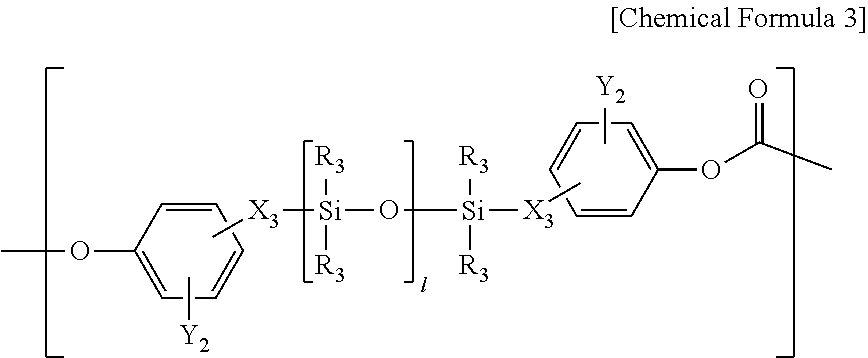Copolycarbonate and composition comprising the same
a technology of copolycarbonate and composition, applied in the field of copolycarbonate and a composition comprising the same, can solve the problems of high production cost and conversely low melt index, and achieve the effect of improving impact strength and melt index properties
- Summary
- Abstract
- Description
- Claims
- Application Information
AI Technical Summary
Benefits of technology
Problems solved by technology
Method used
Image
Examples
preparation example 1
ganosiloxane (AP-30)
[0134]
[0135]42.5 g (142.8 mmol) of octamethylcyclotetrasiloxane and 2.26 g (16.8 mmol) of tetramethyldisiloxane were mixed. The mixture was then placed in 3 L flask together with 1 part by weight of an acid clay (DC-A3) relative to 100 parts by weight of octamethylcyclotetrasiloxane, and reacted at 60° C. for 4 hours. After completion of the reaction, the reaction product was diluted with ethyl acetate and quickly filtered using a celite. The repeating unit (n) of the unmodified polyorganosiloxane thus prepared was 30 when confirmed through 1H NMR.
[0136]To the resulting terminal-unmodified polyorganosiloxane, 9.57 g (71.3 mmol) of 2-allylphenol and 0.01 g (50 ppm) of Karstedt's platinum catalyst were added and reacted at 90° C. for 3 hours. After completion of the reaction, the unreacted polyorganosiloxane was removed by conducting evaporation under the conditions of 120° C. and 1 torr. The terminal-modified polyorganosiloxane thus prepared was pale yellow oil an...
preparation example 2
ganosiloxane (AP-60)
[0137]
[0138]57.5 g (193.2 mmol) of octamethylcyclotetrasiloxane and 2.26 g (16.8 mmol) of tetramethyldisiloxane were mixed. The mixture was then introduced in 3 L flask together with 1 part by weight of an acid clay (DC-A3) relative to 100 parts by weight of octamethylcyclotetrasiloxane, and reacted at 60° C. for 4 hours. After completion of the reaction, the reaction product was diluted with ethyl acetate and quickly filtered using a celite. The repeating unit (n) of the unmodified polyorganosiloxane thus prepared was 60 when confirmed through 1H NMR.
[0139]To the resulting terminal-unmodified polyorganosiloxane, 7.07 g (60.6 mmol) of 2-allylphenol and 0.01 g (50 ppm) of Karstedt's platinum catalyst were added and reacted at 90° C. for 3 hours. After completion of the reaction, the unreacted polyorganosiloxane was removed by conducting evaporation under the conditions of 120° C. and 1 torr. The terminal-modified polyorganosiloxane thus prepared was pale yellow oi...
preparation example 3
ganosiloxane (MB-30)
[0140]
[0141]The polyorganosiloxane was prepared in the same manner as in Preparation Example 1, except that 3-methylbut-3-enyl 4-hydroxybenzoate (14.7 g) was used instead of 2-allyphenol, and the repeating unit (m) was 30, which was confirmed through 1H NMR and designated as MB-30.
PUM
| Property | Measurement | Unit |
|---|---|---|
| reaction temperature | aaaaa | aaaaa |
| temperature | aaaaa | aaaaa |
| temperature | aaaaa | aaaaa |
Abstract
Description
Claims
Application Information
 Login to View More
Login to View More - R&D
- Intellectual Property
- Life Sciences
- Materials
- Tech Scout
- Unparalleled Data Quality
- Higher Quality Content
- 60% Fewer Hallucinations
Browse by: Latest US Patents, China's latest patents, Technical Efficacy Thesaurus, Application Domain, Technology Topic, Popular Technical Reports.
© 2025 PatSnap. All rights reserved.Legal|Privacy policy|Modern Slavery Act Transparency Statement|Sitemap|About US| Contact US: help@patsnap.com



